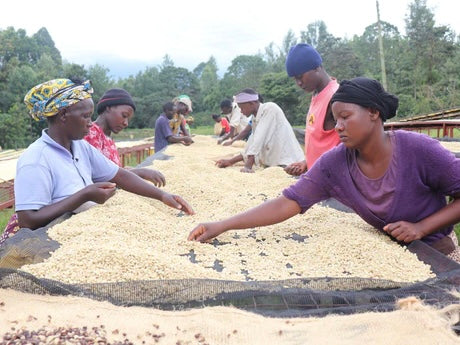
AB GONDO/KENYA
AB GONDO / KENYA
Flavor Profile :
Blood Orange, Stone fruit, Herb tea.
Factory Name : Gondo Factory
Cooperative : New Kiriti Farmers’ Cooperative Society
Producer : 727 small holders
Region : Muranga > Mathioya
Country : Kenya
Variety : SL 28、K7、Ruiru 11、Batian
Process : Fully Washed
Altitude : 1900 masl
Harvest : 2021-2022
This coffee is produced in an area known as Muranga county.Nyeri is the leading producer of top-quality coffee in Kenya. Still, Muranga is adjacent to Nyeri, and the coffee grown here is close to Nyeri in taste and of excellent quality.
AB Gondo has a concentrated citrus and soft, herbal tea-like flavor profile. Compared to the AA Kianderi / AB Karimikui released this year, it has a lighter, brighter fruit impression.
Gondo is the name of the factory where this coffee is processed, and the factory operates as a refining facility for coffee purchased from small farmers in the surrounding area. In addition, a growers' cooperative is organized to oversee the factory.

The New Kiriti Farmers Cooperative Society, which operates three factories in Gondo, Kayu, and Kirimahiga, was founded and registered on 14 October 1998.
The cooperative is run by seven management committee members and three supervisors, plus 19 permanent staff and about 25 seasonal workers, with a membership of 2,469, of whom 900 (about 40%) are women and 1,569 (about 60%) are men.
The Gondo Factory currently has 727 members involved in coffee production.
Neighboring coffee-growing areas surround the region, and several factories are scattered.
This allows small coffee growers the freedom to choose where to deliver their cherries, and competition for high-quality cherries is intense in the region.
Therefore, to attract high-quality cherries from many growers, factories also need to offer attractive conditions to growers.
If they can produce high-quality coffee and sell it at a higher price, they can pay a second reward to the grower from the profit made after the sales and production costs.
In the case of some proven factories, 85% or more of the selling price can be returned to the producer.
Producers choose the factory that buys their cherries on better terms, so the factory also controls the production of high-quality coffee with strict standards, from refining to sales.

The cherries are harvested by hand while carefully selected and transported to the factory on the same day.
When the grower arrives at the collection point (collection area), bags are emptied, usually on the floor (under cover), to remove unripe cherries, overripe cherries and cherries infected with CBD (a disease caused by a fungus).
The responsible person inspects the quality before weighing the cherries, and the grower receives an advance payment, which is part of his remuneration.
The factory records the delivery information from each grower, and a receipt is issued for the advance payment.
This receipt is proof of payment entitlement after the coffee has been sold.
After the cherries have been weighed, they are placed in a pulper.
Through the machine, the cherries flow out with water as a
parchment with the pulp removed. After the pulper has removed the skins, the cherries are processed in a wet process using the clear waters of the Kananagh River.
In this process, the densest beans in the water channel sink and pass directly through the water channel to a fermentation tank as P1 (parchment 1), while the semi-dense beans are sent to another fermentation tank as P2.
The floating material, P3, is considered low-grade and is usually sent straight to the drying table.

The dense coffee is then dry fermented (fermented without water) in painted concrete tanks.
It is usually fermented for 16-18 hours. In many factories, water is added every 6-8 hours to stir and clean the parchment, which is drained again.
After fermentation in the tanks, the coffee is skin-dried on hessian mesh matting for one day.
This is to remove any water from the surface of the parchment quickly.A day later, the coffee is transferred to a traditional drying table, usually on a wire mesh with a hemp cloth or shade net.
During the hottest part of the day, between 12 pm and 2 am, and at night, the coffee must be covered with plastic.Drying takes some days, depending on the weather and rainfall until the target moisture content of 10.5-11.5% is reached.The dry parchment is then hulled, graded, sorted, bagged and marketed by Sustainable Management Services Ltd either through the Nairobi Coffee Exchange Auction or direct Sale to overseas buyers.

ご購入は下記リンクからどうぞ!
→ AB GONDO / KENYA🇰🇪



